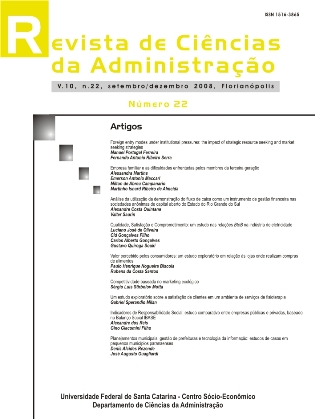Valor percebido pelos consumidores: um estudo exploratório em relação às lojas onde realizam compras de alimentos
DOI:
https://doi.org/10.5007/2175-8069.2008v10n22p104Resumo
No Brasil, os varejos de grande escala estão perdendo espaço para os formatos menores como pequenos supermercados, feiras e padarias. Os consumidores buscam realizar suas compras em locais que diminuam o ônus e aumentem o bônus na realização das compras. Para compreensão desse fenômeno, formulou-se o problema de pesquisa: quais os ônus e bônus que os consumidores percebem existir na escolha de um determinado formato de loja para realizarem suas compras de alimentos? Uma revisão do conhecimento a respeito de valor percebido e de seus antecedentes foi feita. Em seguida uma pesquisa exploratória em profundidade com 51 donas-de-casa (26 de baixa renda e 25 de alta) foi conduzida em uma média cidade brasileira. Os resultados apontaram a preocupação das consumidoras com a questão do preço e do tempo de viagem (proximidade). Os valores de Holbrook (1999) também foram analisados, bem como os esforços e os riscos percebidos. Na conclusão são apresentadas as limitações e as sugestões para novas pesquisas.
Downloads
Publicado
Como Citar
Edição
Seção
Licença
O autor deve garantir:
- que haja um consenso completo de todos os coautores em aprovar a versão final do documento e sua submissão para publicação.
- que seu trabalho é original, e se o trabalho e/ou palavras de outras pessoas foram utilizados, estas foram devidamente reconhecidas.
Plágio em todas as suas formas constituem um comportamento antiético de publicação e é inaceitável. RCA reserva-se o direito de usar software ou quaisquer outros métodos de detecção de plágio.
Todas as submissões recebidas para avaliação na revista RCA passam por identificação de plágio e autoplágio. Plágios identificados em manuscritos durante o processo de avaliação acarretarão no arquivamento da submissão. No caso de identificação de plágio em um manuscrito publicado na revista, o Editor Chefe conduzirá uma investigação preliminar e, caso necessário, fará a retratação.
Os autores cedem à RCA os direitos exclusivos de primeira publicação, com o trabalho simultaneamente licenciado sob a Licença Creative Commons (CC BY) 4.0 Internacional.

Os autores têm autorização para assumir contratos adicionais separadamente, para distribuição não exclusiva da versão do trabalho publicada neste periódico (ex.: publicar em repositório institucional, em site pessoal, publicar uma tradução, ou como capítulo de livro), com reconhecimento de autoria e publicação inicial neste periódico.
Esta licença permite que qualquer usuário tenha direito de:
Compartilhar – copiar, baixar, imprimir ou redistribuir o material em qualquer suporte ou formato.
Adaptar – remixar, transformar e criar a partir do material para qualquer fim, mesmo que comercial.
De acordo com os seguintes termos:
Atribuição – Você deve dar o crédito apropriado (citar e referenciar), prover um link para a licença e indicar se mudanças foram feitas. Você deve fazê-lo em qualquer circunstância razoável, mas de maneira alguma que sugira ao licenciante apoiar você ou o seu uso.
Sem restrições adicionais – Você não pode aplicar termos jurídicos ou medidas de caráter tecnológico que restrinjam legalmente outros de fazerem algo que a licença permita.


